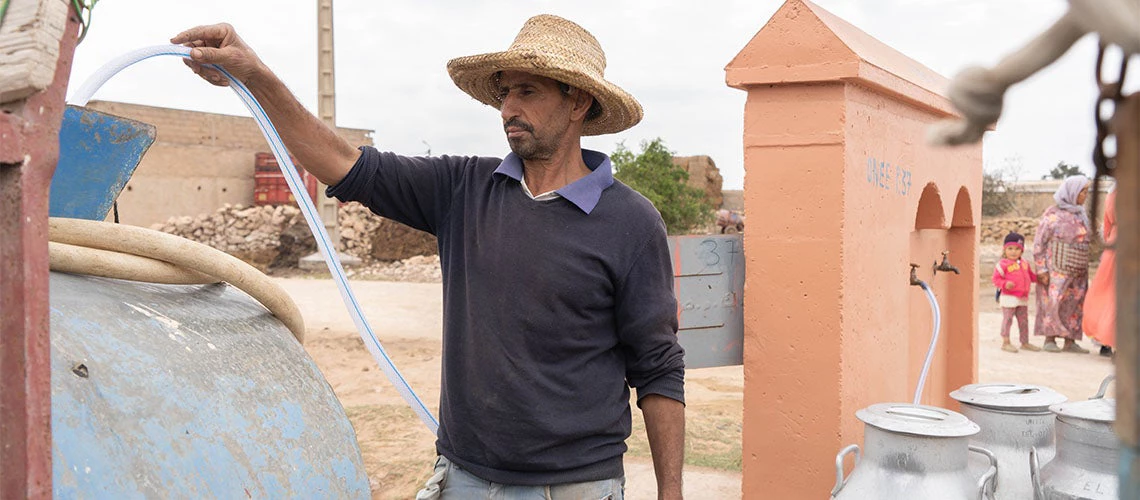 Man filling water tank
Man filling water tank
Since COP27 in Egypt last year, the World Bank has been working hard to implement recommendations in our flagship Country Climate and Development Reports (CCDR). Many of these recommendations tackle water scarcity and its nexus with agriculture, aligning climate-responsive investments in the Middle East and North Africa (MENA) with the region’s development needs. Indeed, the MENA region is at a critical juncture, grappling with the complex challenges posed by climate change and what priorities to focus on first. What’s emerged from the World Bank’s CCDRs in MENA so far is that water security is a common threat across the region and demands urgent attention.
Uncovering the climate impact
The CCDRs that have been completed in MENA to date (Egypt, Iraq, Jordan, Morocco, and Tunisia) projected real GDP losses ranging from 1.1 to 6.6% by mid-century. While these impacts vary from country to country, water security is the primary driver of these losses.
For instance, in Tunisia by 2050, a staggering 71% of climate-linked real GDP losses are attributed to water scarcity. In Lebanon, the combined projections of increased heat and decreased precipitation are predicted to reduce yearly water availability by up to 9% throughout the year, with a devastating 50% decline during the dry season by 2040. In the West Bank and Gaza, a 10% reduction in rainfall is poised to minimize aquifer recharge from 14% to 24%. A more severe scenario, featuring a 15% reduction in annual precipitation, could lead to even graver consequences, with declines ranging from 28% to 50%. These numbers underscore the urgency of comprehensive water resource management and conservation efforts.
Addressing the looming water crisis with nexus solutions
The MENA region's unique characteristics highlight the intricate interdependencies between water, energy, and food production. The thirst of the agricultural sector, coupled with energy-intensive water supply systems such as desalination and wastewater treatment, reflects the deep connections across these sectors. For example, in Tunisia, agriculture is the largest water user in the country, accounting for over 75% of total water usage when agricultural use is not restricted. The agricultural sector is important for the national economy, contributing 9.6% of GDP in 2022 and employing 14% of the active population in 2019. It also contributes to food security.
Given the critical share of water use in agriculture, MENA CCDRs recommend policies to focus on two key areas: substituting freshwater with treated wastewater in agriculture and improving water-use efficiency through demand-side measures, including more modern irrigation methods. In Iraq, improving water-use efficiency could offset climate change effects, with potential GDP losses shrinking with each 10 to 20% increase in efficiency.
Agriculture remains a cornerstone of economic activity in the MENA region, employing a significant portion of the workforce and serving as a vital source of jobs and income, particularly in rural areas. While it's essential to reduce freshwater consumption, climate action along the water-energy-agriculture nexus can have a profound positive socioeconomic impact. In the West Bank, access to land and water resources, especially in the fertile Jordan Valley, holds the key to driving economic growth through agriculture. Similarly, in Iraq, agriculture plays a pivotal role in diversifying the economy away from heavy reliance on oil exports. Protecting farmers entails shifting crop patterns, adopting drought-tolerant crops, promoting higher-value crops, enhancing irrigation technologies, and embracing nature-based solutions.
A year of translating CCDR recommendations into action
The World Bank has so far mobilized around US$800 million to directly support CCDR recommendations that tackle water scarcity. Our CCDR-informed interventions in Morocco (US$ 350 million), Jordan (US$ 250 million) and Lebanon (US$200 million) respond directly to known and emerging climate-linked challenges that have been examined in the CCDRs.
The three projects highlighted above respond to critical adaptation and resilience needs, with interventions specifically aimed at strengthening water governance and institutions, improving financial sustainability of the water sector, supporting climate-smart agriculture, especially in enhancing irrigation efficiency and productivity, and expanding the use of renewable energy to support the up scaling of wastewater treatment and reuse.
The MENA region is at a pivotal moment in its climate journey and the CCDRs for the region underscore two fundamental messages: the imperative to build resilience in critical sectors like water, agriculture, and urban development, while safeguarding vulnerable communities; and the necessity of implementing decarbonization pathways that align with economic growth and fiscal constraints.
The CCDRs have been instrumental in identifying the challenges and opportunities in the region, offering evidence-based solutions to mitigate climate change's impact. Addressing water scarcity, embracing the water-energy-food nexus, and protecting agriculture are pivotal steps toward a resilient and sustainable future. By translating CCDR recommendations into action, MENA countries are taking the critical steps needed to forge a path towards climate resilience and economic growth in the face of mounting challenges.


Join the Conversation